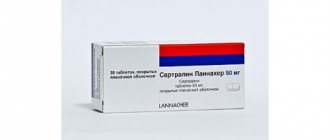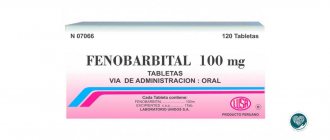Indications
◊ Recommendations of the Russian Ministry of Health
F32 Depressive episode
F33 Recurrent depressive disorder
F40.1 Social phobias
F41.0 Panic disorder (episodic paroxysmal anxiety)
F42.9 Obsessive-compulsive disorder, unspecified
F43.1 Post-traumatic stress disorder
◊ FDA recommendations
- Major depressive disorder
- Premenstrual dysphoric disorder
- Panic disorder
- Post-traumatic stress disorder
- Social phobia
- Obsessive-compulsive disorder (OCD)
- Generalized anxiety disorder (GAD)
◊ Recommendations from UK Medicines and Healthcare Products Regulatory Agency
- Major depressive disorder
- Panic disorder with/without agoraphobia
- OCD in adults and children from 6 years of age
- Social phobia
- Post-traumatic stress disorder
◊ Using Off-label
- Prevention of arterial hypotension during hemodialysis [6]
- Itching [7]
Mechanism of action and pharmacokinetics
Selectively blocks (mainly through serotonin 1A receptors) the reuptake of serotonin by the presynaptic membrane of brain neurons and platelets. With long-term use, it reduces the number of serotonin 5-HT1A and adrenergic receptors in the central nervous system. Sertraline also has some ability to block dopamine reuptake, which may increase dopamine neurotransmission. Sertraline also binds to sigma 1 receptors, which may explain its anti-anxiety effects.
.
- Sertaline is metabolized by several cytochrome P450 (CYP) enzymes: CYP2B6, CYP2C19, CYP2C9, CYP2D6 and CYP3A4, as well as monoamine oxidases and glucuronyltransferases [10]
- Maximum plasma concentration after 4.5-8.4 hours
- Half-life 22-36 hours;
- The half-life of metabolites is 62-104 hours [7].
Pharmacokinetics
Suction
Absorption is high, but at a slow rate. When taking the drug simultaneously with food, bioavailability increases by 25%, Cmax increases by 25% and Tmax decreases.
In humans, when taking sertraline at a dose of 50 to 200 mg 1 time / day for 14 days, Cmax was achieved 4.5-8.4 hours after administration. Cmax and AUC are proportional to the dose within the range of 50-200 mg of sertraline 1 time / day for 14 days, while the linear nature of the pharmacokinetic dependence is revealed.
Distribution
Plasma protein binding is about 98%.
According to the final T1/2, an approximately twofold cumulation of the drug is observed until the onset of equilibrium concentrations after 1 week of treatment (dose 1 time/day).
Metabolism
Sertraline undergoes active biotransformation during the “first pass” through the liver. The main metabolite found in plasma, N-desmethylsertraline, is significantly inferior (about 20 times) to sertraline in activity in vitro and is virtually inactive in in vivo models of depression.
Sertraline and N-desmethylsertraline are actively biotransformed.
Removal
The average T1/2 of sertraline in young and elderly men and women is 22-36 hours. T1/2 of N-desmethylsertraline varies between 62-104 hours. Metabolites are excreted in feces and urine in equal quantities. Only a small part of the drug (less than 0.2%) is excreted unchanged in the urine.
Pharmacokinetics in special clinical situations
The pharmacokinetic profile in adolescents and elderly patients does not differ significantly from that in patients aged 18 to 65 years.
The pharmacokinetics of sertraline in children with OCD have been shown to be similar to those in adults (although the metabolism of sertraline is somewhat more active in children). However, given the lower body weight in children (especially those aged 6-12 years), it is recommended to use the drug in a lower dose to avoid excessive plasma levels.
In patients with liver cirrhosis, T1/2 of the drug and AUC increase compared to those in healthy people.
Treatment regimen
◊ Dosage and dose selection
- Optimal dose: 50-200 mg/day
- Depression and OCD: start with 50 mg and wait a few weeks, but can increase every week to a maximum of 200 mg/day
- Panic disorder, PTSD, social anxiety: start with 25 mg, after a week increase to 50 mg, wait a few weeks to assess whether to increase, maximum 200 mg/day
- Premenstrual dysphoric disorder: 50 mg/day throughout the menstrual cycle or only in the luteal phase
- Itching: 25-100 mg/day [7]
- Prevention of hypotension during hemodialysis: 100 mg/day [6].
- For many patients, a dose of 50 mg/day is not sufficient [1]
- For severe anxiety and agitation, the initial dose should be lower, the titration should be slower, and trazadone or benzodazepine should be added.
- If the patient has a history of intolerance to antidepressants, start with a dose of 12.5 mg
- If anxiety, insomnia, agitation, or akathisia occur at the beginning of treatment or after interruption of treatment, the possibility of bipolar disorder should be considered and switched to a mood stabilizer or an atypical antipsychotic
◊ How quickly it works
- In some patients it begins to work immediately.
- Begins to act after 2-4 weeks.
- If there is no effect after 6-8 weeks, you need to increase the dose or switch to another drug.
- To prevent relapse, it can be taken for many years.
◊ Expected result
- Complete remission.
- After the symptoms of depression disappear, you should continue taking it for 1 year if this was the treatment of the first episode. If this is to treat a recurrent episode, treatment can be extended indefinitely.
- Use in the treatment of anxiety can be indefinite [1].
◊ If it doesn't work
- Change the dose, switch to another medicine or add an auxiliary drug;
- Connect psychotherapy;
- Review the diagnosis by identifying comorbid conditions;
- In patients with undiagnosed bipolar affective disorder, the effectiveness of treatment may be low, in which case it is necessary to switch to a mood stabilizer [1].
- In the acute phase of severe depressive disorder, which is accompanied by psychotic or catatonic symptoms, as well as in patients with current suicidal ideation, electroconvulsive therapy should be considered [4].
◊ How to stop taking it
- Gradually reduce the dose to avoid withdrawal symptoms;
- For many, this scheme works: reduce by 50% in 3 days, then by another 50% in 3 days, then stop;
- If the withdrawal syndrome is very strong, you need to increase the dose and wait until the withdrawal symptoms go away;
- It is important to distinguish withdrawal syndrome from the return of disease symptoms [1].
◊ Treatment combinations
- For insomnia: trazadone
- In the USA, sertraline is combined with bupropion. This combination is called “Well-loft”.
- For fatigue, drowsiness, loss of concentration: modafinil [3].
- Combinations with other antidepressants may activate bipolar disorder and suicidal ideation
- For bipolar depression, psychotic depression, treatment-resistant depression, treatment-resistant anxiety disorder: mood stabilizers, atypical antipsychotics
- For anxiety disorder: gabapentin, tiagabine
- Benzodiazepines
Side effects
From the digestive system:
dyspeptic symptoms (flatulence, nausea, vomiting, diarrhea, constipation), abdominal pain, pancreatitis, dry mouth, hepatitis, jaundice, liver failure, decreased appetite (rarely increased), even anorexia; rarely, with long-term use - an asymptomatic increase in transaminase activity in the blood serum occurs. Discontinuation of the drug in this case leads to normalization of enzyme activity.
From the cardiovascular system:
palpitations, tachycardia, arterial hypertension.
From the musculoskeletal system:
arthralgia, muscle cramps.
From the central nervous system and peripheral nervous system:
extrapyramidal disorders (dyskinesia, akathisia, teeth grinding, gait disturbance), involuntary muscle contractions, paresthesia, fainting, drowsiness, headache, migraine, dizziness, tremor, insomnia, anxiety, agitation, hypomania, mania, hallucinations, euphoria, nightmares, psychosis, decreased libido, suicide, coma.
From the respiratory system:
bronchospasm, yawning.
From the urinary system:
enuresis, incontinence or urinary retention.
From the reproductive system:
sexual dysfunction (delayed ejaculation, decreased potency), galactorrhea, gynecomastia, menstrual irregularities, priapism.
From the senses:
blurred vision, mydriasis, ringing in the ears.
From the endocrine system:
hyperprolactinemia, hypothyroidism, syndrome of inappropriate ADH secretion.
Dermatological reactions:
redness of the skin or flushing of the face, alopecia, photosensitivity reaction, purpura, increased sweating.
Allergic reactions:
urticaria, pruritus, anaphylactoid reaction, angioedema, periorbital edema, facial edema, rarely Stevens-Johnson syndrome and epidermal necrolysis.
From the hematopoietic system:
possible development of leukopenia and thrombocytopenia.
Other:
weight loss or gain, peripheral edema, increased serum cholesterol levels, weakness, bleeding (including nasal, gastrointestinal or hematuria). Rare cases of withdrawal syndrome have been described when stopping treatment with sertraline. Paresthesia, hypoesthesia, symptoms of depression, hallucinations, aggressive reactions, psychomotor agitation, anxiety, or symptoms of psychosis may appear that cannot be distinguished from the symptoms of the underlying disease.
Special patient groups
◊ Patients with kidney problems
No special dose selection is required [1].
◊ Patients with liver disease
Reduce doses or take half as often [1].
◊ Patients with heart disease
Useful in the recovery of depressed patients after a heart attack.
◊ Elderly patients
Some people do better at low doses.
◊ Children and teenagers
- It is necessary to regularly and personally check the patient's condition, especially in the first weeks of treatment.
- Inform adults about the risks.
- Approved for the treatment of OCD
- Ages 6-12: Initial dose 25 mg/day
- From 13 years old – adult doses [1].
◊ Pregnant women
- Not recommended for pregnant women, especially in the first trimester [9]
- All risks should be weighed and compared
- Bleeding can be expected during childbirth
◊ Breastfeeding
- The medicine passes into breast milk.
- If the infant shows signs of irritation or sedation, discontinue feeding or sertraline
- However, treatment after childbirth may be necessary, so the risks should be weighed.
- Sertraline has proven effective in treating postpartum depression
- Sertraline is the most studied antidepressant used in breastfeeding women. It is the preferred antidepressant during lactation [8].
Interaction with other substances
- Tramadol increases the risk of seizures
- Cannot be used with MAO inhibitors. After stopping taking MAO inhibitors, 14 days should pass. Start treatment with MAO inhibitors 7 days after stopping citalopram.
- Together with anticoagulants, probably increases the risk of bleeding.
- Urine tests for benzodiazepines may give false-positive results in those taking sertraline.
- Due to CYP450 2D6 inhibition, sertraline may increase thioridazine levels and cause arrhythmia
- Due to inhibition of CYP450 3A4, sertraline may increase the levels of alprozalam, buspirone and triazolam
- By inhibiting CYP450 3A4, sertraline may theoretically increase concentrations of certain cholesterol-lowering HMG-CoA reductase inhibitors, particularly simvastatin, atorvastatin, and lovastatin, but not pravastatin or fluvastatin, which would increase the risk of rhabdomyolysis. Therefore, coadministration of sertraline with certain HMG CoA reductase inhibitors should be done with caution.
Side effects and other risks
◊ Mechanism of side effects
- Side effects are caused by an increase in serotonin. Most side effects occur immediately after starting treatment and go away over time, while the therapeutic effects increase over time.
- Sertraline may interfere with dopamine reuptake, which may lead to agitation and anxiety early in treatment. On the other hand, increased serotonin levels may cause decreased dopamine release and may contribute to cognitive decline and apathy in some patients.
◊ Side effects
- Gastroenterological (reduced appetite, nausea, diarrhea, constipation)
- Insomnia, sedation, agitation, tremor, headache
- Sweating Rare hyponatremia in the elderly (resolves after discontinuation of sertraline) [1]
- Dangerous side effects: seizures, mania, suicidal ideation
- Weight gain: rare
- Sedation: rarely
- Sexual dysfunction: yes (dose-dependent effect)
◊ What to do about side effects
- Wait;
- If sertraline activates, take in the morning;
- Reduce dose to 25 mg or 12.5 mg, when side effects go away, increase dose;
- If side effects do not go away, change the drug [1]
◊ Long-term use
Safely
◊Addiction
No.
◊ Overdose
- Very rare cases of fatal overdoses. Fatalities are associated with the combination of sertraline with alcohol and drugs.
- Vomiting, sedation, cardiac arrhythmia.
Dosage
The antidepressant Zoloft is prescribed by a doctor if indicated; it is important that when taking this medication the patient strictly follows the instructions for use and the doctor’s recommendations. If you take Sertraline outside of your prescription, you may experience unpleasant side effects. Typically, Zlolft tablets are taken in the morning and evening. The following release forms are available:
- tablets (dosage 25, 50,100 mg);
- solution for oral administration (dosage depends on the individual factors of the patient’s body).
Depending on the state of health, age and disease, the doctor prescribes a certain dose of the drug. If the patient is elderly, the dose of the medicine should be reduced, since in addition to the main disease for which this drug is used, concomitant ones may also be present. The specialist adjusts the required dose until it produces the best effect. It is important to understand that abruptly stopping Zoloft may cause undesirable changes in the patient’s health. Among the consequences of sudden withdrawal: sudden changes in mood, nervousness, irritability, nausea, dizziness, headache, insomnia, unreasonable fears.
Expert advice
- An antidepressant with the best proven cardiac safety.
- Compared to some other antidepressants, it is more likely to cause gastroenterological side effects (diarrhea) [1].
- Sertraline shows effectiveness in the treatment of depression in patients with vascular cognitive impairment [5].
- May be a more effective treatment for women with PTSD or depression than for men with PTSD or depression, but clinical significance is unknown
- SSRIs may be less effective in women over 50, especially if they are not taking estrogen
- Some evidence suggests that treatment with sertraline only during the luteal phase may be more effective than continuous treatment in patients with PMDD.
- In combination with olanzapine, sertraline has been shown to be effective in the treatment of psychotic depression [10]. It is important to consider that sertraline increases the clearance of olanzapine by 30%. Moreover, this effect is difficult to explain by the interaction of drugs at the level of cytochromes. This may be related to P-glycoprotein.
- The fact that sertraline can be metabolized through multiple pathways is clinically useful: it is less susceptible to drug interactions than antidepressants that rely on only one enzyme or pathway as their primary metabolic pathway.
- An additional advantage of sertraline over some other SSRIs (especially fluoxetine, paroxetine and fluvoxamine) is that it is not a strong inhibitor of any specific CYP enzyme [10].
Overdose
Symptoms:
no severe symptoms were detected in case of an overdose of sertraline even when using the drug in high doses. However, when administered simultaneously with other drugs or alcohol, severe poisoning can occur, including coma and death.
In case of overdose, manifestations of serotonin syndrome are possible (nausea, vomiting, drowsiness, tachycardia, agitation, dizziness, psychomotor agitation, diarrhea, increased sweating, myoclonus and hyperreflexia).
Treatment:
There are no specific antidotes. Intensive supportive care and constant monitoring of vital body functions are required. Inducing vomiting is not recommended. The administration of activated carbon may be more effective than gastric lavage. The airway must be maintained. Sertraline has a large Vd, and therefore increased diuresis, dialysis, hemoperfusion or blood transfusion may be ineffective.






